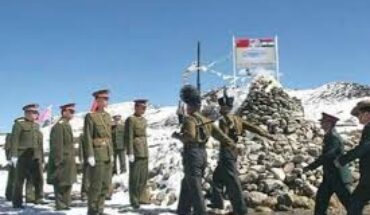With India’s Defense exports, especially artillery shells being siphoned off to Ukraine has alerted New Delhi.
Initially, it may adversely affect the country’s exports of defense systems and ammunition, but her defense production companies might resort to stringent regulations. The issue has recently cropped up, when the Russian foreign minister, Sergey Lavrov, took up the issue with his Indiancounterpart, S.Jaishankar.
The Russians told India how the artillery shells were being diverted from the European buyers to Ukraine.
In spite of this setback to the Indian defense exports, her multi-pronged strategy to boost indigenous production of high-tech weapons and developing security systems stressing self-reliance is to continue.
No More a Holy Cow – During the past one decade, India’s defense doctrine has undergone paradigm changes. Its focus has shifted from preparing only for the defense to the concept of the offensive defense. It means, if you engage India in one sector, the conflict might escalate to other regions too.
Since 1947, India has been averse to joining any defense pact , avoiding arms race and genuinely subscribing to the concept of peace, non-violence and opposition to nuclear weapons. However, the situation has changed in recent years. With the new war strategies being witnessed in the two war theaters, the Russian-Ukrainian conflict in Eastern Europe, and the escalation of the limited terrorists’ attack initiated by the Hamas with the support of Iran now triggering off into a full-scale flare-up.
The successful use of technologies such as drones or the unmanned aircrafts equipped with deadly missiles could cause havoc on the enemy. The formidable armored vehicles and tanks could even destroy the artillery with a negligible cost. Also, the export of armaments helps in generating resources for further research; for example, initially the US had developed internet it’s defense communication, but later it has led to the development of mobile phones and using the communication satellites.
The 1962 Chinese attack has also transformed the Indian emphasis towards peace and war. The Indian army just having the guns of the World War-II years could not resist the Chinese army which had automatic guns. In 1965, the Pakistani attack further exposed India’s vulnerability. Later, in 1967, Indira Gandhi, the legendary Prime Minister, for the first time punished the much-trumpeted People’s Liberation Army (PLA) in the Nathu-la conflict. The then Chinese ambassador in New Delhi pleaded that the casualties of the PLA in the conflict should not be revealed; however later Vietnam also taught a lesson to the PLA for daring to attack the freedom-loving people.
In 1967, the peaceful implosion of a thermo-nuclear device at Pokhran in Rajasthan further established the Indian capacity to develop her own nuclear weapons, if the threats continue to haunt her.
In spite of the three wars, the Chinese aggression in 1962 and two Pakistani attacks of 1965 and 1971, India did not join the nuclear club. She detonated nuclear devices only in 1998, when China helped Pakistan to develop nuclear weapons.
India despite her technological achievements did not enter in the sensitive field of the production of nuclear weapons and defense systems. Her reluctance to seek a share in the multi-billion USD international armament market was continued. However, during the past 10 years of the Modi regime, India has decided to enter the global armament market. Admittedly, it has her own challenges such as the buyers might divert the weapons and explosives to other countries. The issue recently hit the headlines, when Russia complained that Ukraine is using shells of Indian origin. The countries like the Czech Republic, according to the available information, purchased artillery shells from India, which were later sold off to Ukraine.
Blending of Technologies– The ongoing negotiations with the US and French authorities regarding the development of engines for the stealth aircrafts and nuclear-powered submarines in India is expected to be finalized by the end of this month.
The focus is that India’s strategic partners, the US and France should share their technologies with her. France has indicated that it has no reservation on the issue of the transfer of technologies, but the US companies have shown reluctance that they could share only 80 percent of their technologies.
The Indian negotiators, however, cautioned Americans that if they do not share and cooperate with India, China will overtake them by 2030 in the development of new strategic weapons. It Is also being stated that with the launch of nuclear powered submarines developed in her shipping yards, India has acquired the necessary technological competence not only to assimilate the new technologies, but also ready to contribute to further research.J
India’s second nuclear submarine, Aright, was commissioned on August 29, this year, which could be equipped with ballistic missiles. The success of Aright has prompted the Indian authorities to expand the indigenous base for the production of a new generation of fighter aircrafts and naval ships.
Upgrading Indian Technologies – With the commissioning of Arihant, the first nuclear submarine in 2016, India’s strategic policy shifted to the offensive defense. It has also become necessary following the unprecedented expansion of the Chinese navy and its air force. The Chinese have already declared that it would not allow the Indian Ocean, a lake of India. In recent years, it has been supplying new weapon systems to Pakistan, including new frigates and submarines.
It is hoped that with the National Security Advisor, Ajit Doval’s meeting with the Diplomatic Advisor, Emmanuel Bonne, on September 30 and October one in Paris, the decks will finally be cleared for the assimilation of new technologies in the time Indian defense systems.The forthcoming meeting is a sequel to the visit of the French President Emmanuel Macron on the Republic Day, January 26, this year.
The French cooperation in the development of water drones, submarines and aircraft engines have become crucial for India, especially when the security concerns are becoming complex with the sudden expansion of the Chinese navy and airforce. In number of ships, the Chinese navy already has overtaken the American navy
Meanwhile, in spite of a number of meetings held between the US and Indian representatives, the American defense production companies are quite slow in manufacturing aircraft engines and other hi-tech equipment. India, however, continues to be optimistic and hopes that with the saddling of the new President in Washington in 2025, the US Administration will focus on defense partnership with India.
Gopal Misra has been associated with national and international media. His books on journalism and geo-politics have been well-appreciated. Views are personal.






